Tackling the dreaded red mite in chickens.

Red Mite, or Dermanyssus gallinae, is not called the chickens keepers nightmare for nothing. They are small tenacious parasites in the same family as spiders and ticks which come out at night to feed on your chickens blood. Not only do they drain your chickens but red mites transmit a number of viruses and bacteria and can spread diseases amongst your chickens.
The red poultry mite is one of 18 mite species found on domestic poultry.
Table of Contents
- What is red mite?
- How big are Red Mite?
- Do Your Chickens Have Red Mite?
- How to tell if your coop and chickens have red mites:
- What is the best place to find red mite?
- Can red poultry mites kill chickens?
- Where do red mites come from?
- Are plastic coops better for red mite?
- Can humans get red mites from chickens?
- Do red mites die in winter?
- The life cycle of the red mite:
- How to treat chickens for poultry mite infestation:
- How often should you use red mite powder and treatments on chickens?
- Are there natural red mite treatments?
- How to prevent poultry mite infestation:
- Treatments for red and poultry mites:
Red mite are only red when they have fed on your chicken's blood. If they haven't fed they are grey in colour. A bad infestation can take 5% of your hen's blood every night.
Red mites are found in the nooks and crannies of the coop and all the little cracks and dark places where they can hide during the day.
What is red mite?
Red mites are tiny parasites about 1 mm in length which live by drinking your hens’ blood. When unfed they are usually pale grey or whitish in colour but turn red once they have eaten and are swollen with blood.
They are sturdy creatures with 4 pairs of legs and the head, thorax and abdomen united in a single body.
Below: Red mite video.
Below: The red mite and it's egg for comparison. A sketch from an old poultry book.
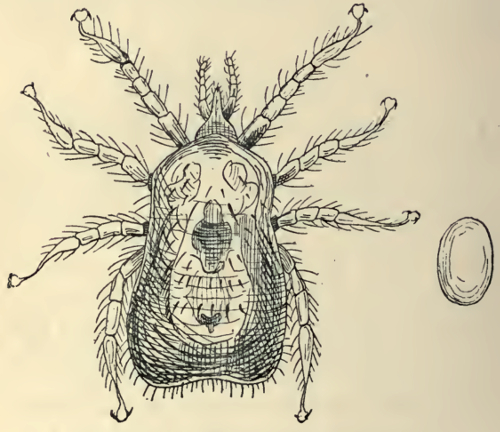
Poultry mites like to feed at night when your chickens are roosting and are moving around less. They don’t usually live permanently on your chickens but rather visit to eat and then go elsewhere, often retreating to safer dark and harder to reach areas of the coop.
The poultry mite lives for only a week but in that time will grow, mate and reproduce abundantly. With such a short life cycle, this can mean that getting rid of mites can be a long and difficult process as it only takes a small number of mites a short time to reproduce and infest your flock.
Poultry mites are at their most active during spring and summer months and become dormant in Fall and Winter. Eggs laid in late Summer may wait until warmer weather before hatching again in Spring.
Red mite is a common external parasite of birds and one of the most hated by poultry keepers. Although very small it can be seen by the naked eye. Mites feed on blood or feathers, skin or scales of birds. Heavy infestations can result in poor health, anaemia, reduced egg production, weight loss or, in extreme cases death.
Below: Red mite on wood in a chicken coop.

Red mite comes out at night to feed on the blood of roosting hens, usually for 1-2 hours. After feeding the mites return to their hiding places in cracks and crevices where they mate and deposit their eggs. Inspection of poultry housing during the day, does not indicate red mite or the extent of the infestation, therefore houses should be checked with a torch when dark at night, when the mites are most active.
How big are Red Mite?
Red mite are two sizes depending on whether they have fed recently or not. They are either small, around 0.5 mm long, and Gray or large, around 1 mm long and red if they have fed in the last 12 hours or so.
Below: A red mite next to a coin as a size comparison.
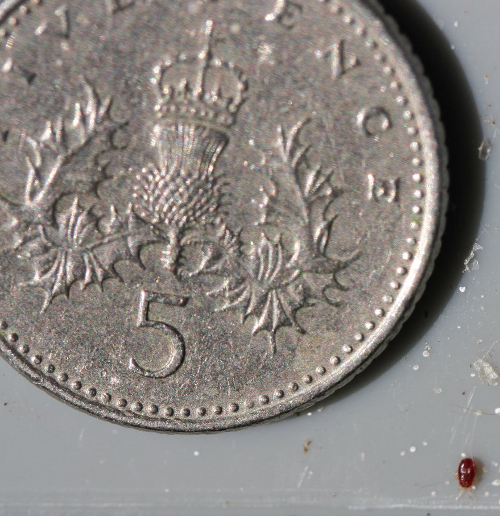
The eggs of red mite are small (0.4 mm x 0.25 mm) oval and pearly white.
Do Your Chickens Have Red Mite?
Spotting red mite in chickens can be hard work as the mites only come out at night. If you suspect you have them the take a look at the vent area or your chickens bottoms as they congregate there more.
At high infestation levels mites cause increased stress to the birds. Look out for tell tale signs, if the birds are reluctant to go into roost at night, the chances are there could be a red mite infestation.
Below: A featherless chickens belly with a rash caused by red mite.
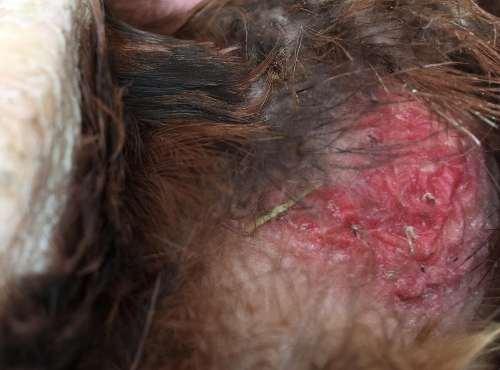
The appearance of the red mite is dependent on when they last fed. When recently fed they appear red and this colour goes through black to grey as the time since the last feed increases.
How to tell if your coop and chickens have red mites:
Poultry mites are tiny and hard to spot, especially during the day when they are hidden and white or grey in colour. The best time to look will be at night when they will be red in colour.
Look in the cracks and gaps of the coop or underneath felt roofing. Take a close look at the ends of perches or underneath nesting boxes. Try wiping with a tissue and if you find it dotted with red splodges then these are likely to be the squashed bodies of recently fed mites.
Symptoms of a red mite infestation:
- Scratching or distracted hens.
- Feather loss.
- Rash, pustules or scabs. Especially on the underside or near the vent.
- Pale comb and wattles.
- Tiredness.
- Lack of appetite.
- Reluctance to enter the coop to lay eggs or roost in the evening.
- Fewer eggs.
- Hens laying eggs in unusual places.
- Blood spots on eggs indicate infestation within the cloaca of an affected hen.
On the chickens themselves, check the feathers nearest to the skin, the legs, vent and under the wings. However, it’s probably easier to find them on the coop rather than the hen.
Below: Red Mite Alert, a small device for checking your chicken coop for red mite.
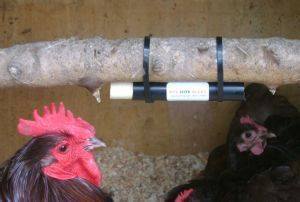
This little device will let you know easily if you have red mite in your coop. Red Mite Alert is a red mite detector. It is a simple reusable device for detecting the presence of red mite in your chicken coop.
What is the best place to find red mite?
There are some classic difficult to treat places on hen houses that red mites love and keepers never seem to get cleared up.
- Under roofing felt or shingles. Large flat areas where you can get thousands of mites and never notice.
- Plywood, OSB or particle board. These laminated or pressed sheet materials are full of little holes that mites love and people can't get into to kill them.
- The ends of the perches.
- Cracks and crevices in the coop.
Below: Mites and eggs on OSB particle board.
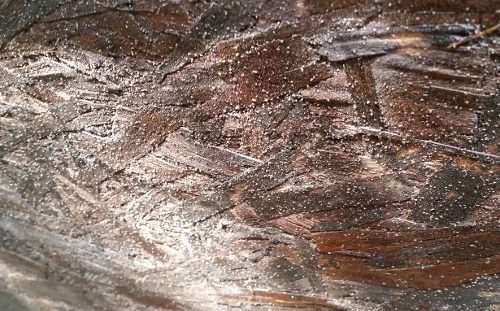
Can red poultry mites kill chickens?
Red mite can kill chickens and quite quickly if left untreated. They can also introduce and spread disease.
Poultry mites pose a major risk to the health of your entire flock, especially young chickens. In smaller numbers, they make your hens restless and hens itching and pecking may pluck their own feathers to get at the mites. This may prevent the laying of eggs too.
Once infestation takes place and you have significant numbers of poultry mites feeding on each chicken, you will see your flock become anaemic and susceptible to other illnesses. If left untreated, then eventually your chickens will perish.
Poultry mites also pose health problems to other animals and humans. They can carry salmonella, other diseases and can also cause dermatitis to humans as well.
Where do red mites come from?
You only need one viable mite to land on your site and you can end up with an infestation. One can lay dozens of eggs every week or so under the right conditions.
- Straw can carry mites. You can bring it onto your site with you without knowing.
- Wild birds or animals. Probably the most common way mites move around.
- Recent flock additions. Not quarantining new birds is another way mites can get onto your chickens.
- You or your pets. You could bring one from a fellow keepers coop or you dog can carry a few in.
These are the 4 most common ways parasites get into your flock.
Are plastic coops better for red mite?
Plastic chicken coops can definitely still get red mite infestations. The mites hide in cracks and there are still plenty of these in plastic coops, like between the different components that make up the coop.
Nest boxes and their filling, perches and panel joints are all likely hiding places.
Below: Plastic coop can still get red mite. They are easier to clean and sterilise with boiling water.

The advantage of plastic coops is that you can clean them more easily and by washing with water over 55 °C (131 °F) you can be sure the mites will perish.
Treat the cracks in plastic house with DE like you would any other coop.
Can humans get red mites from chickens?
Yes, and older houses can easily be infested with mites. Red mite leave their host in the morning after feeding overnight and they will bite people and can cause dermatitis and irritation in humans.
Below: A red mite on a finger.

Red mite will feed on any warm blooded creature they can get their mouth parts into and this includes cats and dogs.
Red mite will be just as happy in a human house as a poultry coop and they could be speed by people and pets.
What to do if you get red mite on yourself:
Have a hot bath or shower with soap as soon as you can and change and wash all of your clothes.
Do red mites die in winter?
Red mite do not die in winter unless the temperature is below -20 °C/-4 °F and are dormant for most of a northern winter. Below 10 °C they are inactive and cannot feed and reproduce. Warmer weather from 10-35°C is ideal for red mite to reproduce which is why they are a problem from Spring to Autumn with a peak in Summer.
Dermanyssus gallinae or red poultry mite can survive for up to 10 months in an empty hen house. Temperatures greater than 45 °C/113 °F and less than -20 °C/-4 °F, have been found to be lethal.
Bear in mind the crack in your coop may be well above the outside temperature so a -20 °C/-4 °F might still not be enough to kill them all.
The life cycle of the red mite:
Red mites only feed on birds in darkness and blood feed for 1-2 hours each night.
Red mites spend most of their life in cracks and crevices and this is where the female mite deposits its eggs.
Below: Mites, nymphs and eggs.
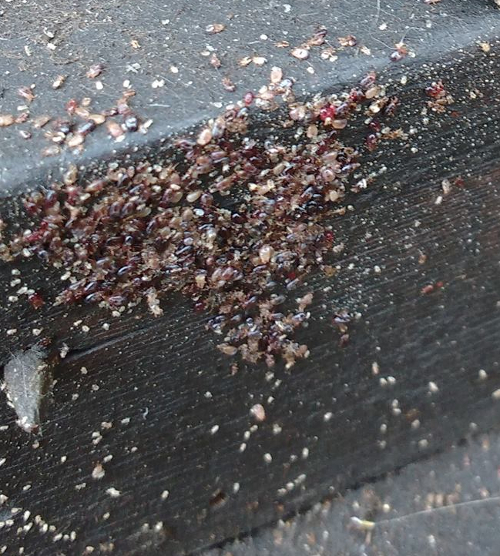
The eggs of red mite are small (0.4 mm x 0.25 mm) oval and pearly white. Under warm conditions the eggs hatch in 2-3 days into 6-legged larvae.
Before the first feed the larvae moult into an 8-legged protonymph (usually within 24 hours of hatching).
Protonymphs start to feed on the roosting birds and moult to a deutonymph that continues to feed before moulting into an adult male or female.
Under favourable conditions a mite can complete a life cycle (egg to egg) in 7 days.
Populations can build up very rapidly within poultry houses and red mite can survive for up to 8 months without a blood meal and, when hidden within cracks, are very resistant to desiccation.
Under ideal conditions the life cycle of the poultry red mite can be completed within 7 days.
The female red mite lays her eggs after a feed.
How to treat chickens for poultry mite infestation:
Inspect your chickens for signs of red mites. Look for small, red or brown bugs crawling on your chickens' feathers, especially around their vent and under their wings. You may also see small red spots of blood on their feathers.
If you find you have a poultry mite infestation, then urgent and comprehensive action and immediately treat your chickens with a safe insecticide, permethrin, absorbacide or Pestene.
- First of all you will need to give the coop a complete clean. Empty everything, clean it thoroughly including all waterers, feeders and any chicken toys you have provided them with.
- Completely remove all bedding, putting it in secure, disposable bags or incinerate if you have a garden burner.
- Spray with the permethrin or insecticide solution.
- Treat all hard to reach places where mites like to live, making sure they are well soaked.
- Do the same to all the parts you have removed including nest boxes, perches and any other fittings. Once soaked leave for an hour.
- Following the hour’s soak, thoroughly brush down and clean your hen house and then hose away all debris – which will no doubt contain the dead mites.
- All the equipment should also be given a good wash with Poultry Shield – if you have a large bucket then use this to soak items before rinsing and placing back.
- Feeders and waterers, even the ones kept outdoors, are also potentially areas where mites may be found. Wash these thoroughly too and spray the surrounding area. Make sure they are rinsed and dried before putting off and water back in them for your animals.
- Treat your chickens with a miticide. There are a number of miticides available that can be used to treat red mites in chickens.
- One area where the spray is not effective is if you have damaged felt roof where poultry mites may have got underneath. The liquid would not be able to fully penetrate here. If this is the case you should replace the roof. Poultry mites find the space between the felt and the wood one of their favourite places to live and breed.
- Take a bath or shower and wash yourself.
- Repeat this after 6 or 7 days. This is because the life cycle is every 7 days and you do not want any mites that may have escaped to lay more eggs.
- Continue to treat with DE or lice powder every week during summer and keep checking and cleaning regularly.
- Add herbs to your chickens' diet. Some herbs, such as garlic, thyme, and oregano, can help to repel red mites. Add these herbs to your chickens' feed or water to help keep them mite-free.
- Build your chickens' immune systems. A healthy chicken is less likely to be affected by red mites. Make sure your chickens have a balanced diet and plenty of fresh water. You can also add supplements to their diet, such as probiotics and vitamins, to help boost their immune system.
- Keep your chicken coop clean and dry. Red mites thrive in moist, warm environments.
I use Poultry shield undiluted, sprayed on the coops first thing in the morning giving it chance to dry out before night time. Once sprayed and dried I sprinkle Diatomaceous earth over the bedding a shavings and it keeps them at bay. It has to be done every week but used together I find them very effective.
How often should you use red mite powder and treatments on chickens?
To effectively treat a red mite infestation you must treat chickens and the coop at least twice and 7 days apart to make sure you get all the mites and their eggs. Preferably three times and follow up with natural treatments afterwards.
Are there natural red mite treatments?
Here are some natural treatments for red mite and they should really only be used in a preventative capacity, If you have a large infestation you will probably need to resort to chemical means first.
- DE or diatomaceous earth is very effective if used regularly - see this on how to use DE for chickens. Opens in a new window.
- Pressure washing the coop. Blast the mites out of the cracks.
- Lavender or some other essential oil. Linalool from lavender is toxic to red mites. The research shows that red mite mortality rates decrease with time so the longer the lavender oil is on the coop the less effective it gets. The benefit is that the killing power of lavender essential oil increases as mites are starved for longer periods of time. Peppermint and Eucalyptus also work.
- Make traps out of corrugated card and trap the mites. Remove during the day and burn.
- You can use a blowtorch to kill the mites directly. The dangers of this method are obvious though!
- Paint your coop with creosote. You need the proper stuff from agricultural merchants not the water down stuff from DIY stores.
- Paint the cracks with a warm mixture of Vaseline and paraffin wax. It smothers and traps them.
- Use a steam cleaner or wall paper stripper to kill them with steam.
- Sticky pest control tape wrapped around the ends of the perches will trap the mites.
How to prevent poultry mite infestation:
The usual way chicken keepers keep poultry mite at bay is by using Diatomaceous earth a safe, inert, chemical free powder made from ground up fossilised shells. It’s free from any poisons and is totally safe to use.
It kills poultry mites by stripping away away their protective waxy coating when they come into contact with it. This causes them to die from dehydration.
When you use Diatomaceous earth, you should sprinkle it:
- Over the coop floor.
- In the bottom of nesting boxes.
- On perches, especially at the ends where they join the coop.
- Any gaps and holes where mites may congregate.
- Where your hens like to have their dust baths.
Doing this will mean that the hens will cover themselves in the powder without you having to physically put too much dust on them yourself.
As a note of precaution, wear rubber gloves and a decorators dust mask when handling the fine powder.
Treatments for red and poultry mites:
There are various treatments available on the market to treat infestations of red mite but they fall into 2 categories. Preventative measures of which the best is DE and insecticides.
With products to kill and treat red mite infestations not all are available in all locations and some are prescription only.
Disinfectants:
One of the best known and easy to buy and use is Jeyes Fluid which will kill red mites.
It is with water and used to clean the coop. When dealing with chemical please follow the manufacturer’s instructions and avoid getting it on yourself or breathing it in.
Does bleach kill red mite?
I don't know, it might do in concentrated form but I personally would avoid using bleach around chickens, it may produce Chlorine gas which is not good for anybodies lungs.
Stick to Smite or Poultry Shield as both are certified for use with chickens.
Organic treatments:
Poultry Shield or Smite is useful for cleaning out the chicken coop and then I dust the coop, nest boxes and perches with diatomaceous earth.
DE is and excellent ongoing treatment
You can buy Poultry Shield here, Smite here and diatomaceous earth here.
They continue working for some time but do need re-applying regularly or after every hen house muck out. These products take time to work and to be effective the treatment needs to be regular.
Exzolt:
Exzolt is administered through the drinking water, in two separate treatments, seven days apart and trials have shown a 99% kill rate. There is no egg withdrawal period and there is a short 14 day withdrawal for meat.
It is prescription only and biblically expensive but you should ask your vet.
Insecticides:
Most insecticides contain permethrin which is a synthetic pyrethroid derived from dried flowers of the Chrysanthemum. Permethrin works as a contact insecticide that damages the nervous system of the insect. It is an effective insecticide and has a low toxicity in mammals so is safe for you and your flock.
These contact kill insecticides should not be used on the birds directly unless specified in the instructions and given an egg withdrawal period.
‘Spot-On’ Treatments like Harkamectin:
These are bought products which contain Ivermectin. They need no dilution, you just put two drops on the neck of the birds you are treating.
I would not use this product on chickens from which you intend to eat the eggs. These are produced for cage birds like pigeons.
